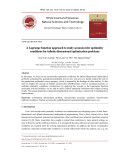
HPU2. Nat. Sci. Tech. Vol 02, issue 03 (2023), 34-41
HPU2 Journal of Sciences:
Natural Sciences and Technology
journal homepage: https://sj.hpu2.edu.vn
Article type: Research article
Received date: 13-10-2023 ; Revised date: 30-11-2023 ; Accepted date: 30-11-2023
This is licensed under the CC BY-NC-ND 4.0
Singular value decomposition and applications in data processing
and artificial intelligence
Thanh-Xuan Cao Thi*
University of Economics - Technology for Industries (UNETI), Ha Noi, Viet Nam
Abstract
Computing matrices is a crucial and prevalent topic in the field of data processing and artificial
intelligence. One of the significant and effective methods for matrix manipulation is Singular Value
Decomposition (SVD). Based on matrix computations using SVD, we can perform various complex
operations such as dimensionality reduction, hidden information detection, optimization, and many
other applications. Singular Value Decomposition is a valuable method in data science, allowing us to
decompose a matrix into its fundamental components. Similar to Principal Component Analysis
(PCA), SVD helps reduce the dimensionality of data while preserving the most important information.
However, SVD can be applied to non-square, non-invertible matrices, and its ability to separate
fundamental components enables us to analyze more complex data. SVD has a wide range of
applications in practical scenarios.
Keywords: SVD, matrix, data
1. Introduction
In recent years, Artificial Intelligence (AI), and more specifically Machine Learning, has emerged
as evidence of the fourth industrial revolution (1 - steam engine, 2 - electricity, 3 - information
technology). Artificial Intelligence is infiltrating every aspect of our lives, and we may not even
realize it. Google and Tesla's self-driving cars, Facebook's facial recognition system, Apple's virtual
assistant Siri, Amazon's product recommendations, Netflix's movie suggestions, Google DeepMind's
* Corresponding author, E-mail: Cttxuan@uneti.edu.vn
https://doi.org/10.56764/hpu2.jos.2023.2.3.34-41

HPU2. Nat. Sci. Tech. 2023, 2(3), 34-41
https://sj.hpu2.edu.vn 35
AlphaGo in the game of Go, are just a few examples among countless applications of AI/Machine
Learning [1].
Machine Learning is a subset of AI. According to the Wikipedia definition, Machine Learning is
the subfield of computer science that "gives computers the ability to learn without being explicitly
programmed." In simple terms, Machine Learning is a smaller field within Computer Science that
enables computers to learn and adapt based on the input data without requiring explicit, hand-coded
instructions.
Because of this, the research and development of Machine Learning algorithms as well as the
creation of applications are high demands for computer scientists. The mathematical foundation of
Machine Learning requires a fundamental understanding of linear algebra, optimization, and
probability and statistics.
Matrix factorization, or matrix decomposition, is a fundamental technique with numerous
important applications, particularly in machine learning. It involves decomposing a matrix into the
product of several specialized matrices. This process has a wide range of benefits, including
dimensionality reduction, data compression, exploring data properties, solving linear equations,
clustering, and many other applications. One prominent application of matrix factorization is in
recommendation systems.
Singular Value Decomposition (SVD) is a form of matrix factorization that finds extensive
applications in problems related to inversion and data analysis. Nowadays, SVD is prevalent in
practical applications such as digital signal processing, approximating values in engineering,
information technology, machine learning, and is employed in search engines on various websites.
However, theoretical research concerning SVD is a relatively new field and can be challenging for
readers interested in delving into this fascinating topic. Therefore, this article aims to provide readers
with the most basic knowledge about SVD factorization and offer an overview of its factorization
form, as well as some essential properties and relevant consequences associated with this
decomposition.
2. Theoretical basis
2.1. Machine learning
The concept of learning is broad, much like the notion of intelligence, and it does not have a
precise definition. According to the dictionary, learning is the process of acquiring knowledge or skills
either from others or by reading, studying, and memorizing. In a broader sense, learning also
encompasses the process of extracting knowledge from observations and practical experiences.
Machine learning has two common meanings:
- Using computers to discover knowledge from data.
- The act of learning within a machine or agent.
- From a technological standpoint, machine learning is a subfield of artificial intelligence in
which researchers study techniques for constructing and developing computer programs capable of
adapting and "learning" from sample data or experience.
To date, there have been many definitions of this concept, but it is difficult to establish a
universally accepted definition. The following definition is derived from T. Mitchell's definition and
provides a mathematical perspective on how a learning program is researched and designed:

HPU2. Nat. Sci. Tech. 2023, 2(3), 34-41
https://sj.hpu2.edu.vn 36
Definition 2.1: A computer program is considered to learn from data or experience E with respect
to a class of tasks T and performance measure P if its performance on tasks T, as measured by P,
improves with data or experience E.
According to this definition, one needs to optimize the performance measure P based on the
analysis of data and experience E to find the best way to perform tasks T.
Example 2.1.
Retail Data Analysis for Supermarkets: Every day, supermarkets sell a large variety of items and
record transaction data (shopping cart copies). From the retail data collected, we can analyze shopping
baskets to predict how likely it is that a customer who buys item A will also buy item B. If this
probability is high, we should place these items close together, making it convenient for customers and
increasing sales compared to having customers search all over. Furthermore, with a good analytical
model, we can also predict the quantity of goods needed in the near future, customer preferences, and
based on that, make adaptive policy decisions. In this example, T represents forecasting, E represents
the stored retail data, and P represents the accuracy of the forecasting results.
Problem 2.1.
The problem of fingerprint matching originates from two tasks: fingerprint identification and
fingerprint verification. In the identification task, one needs to match a fingerprint image obtained
during an investigation with fingerprint images stored in a database to determine if any of the stored
fingerprints belong to the same rolled-out finger as the investigated image. In the verification task, one
needs to verify whether a logged-in fingerprint image (also referred to as the probe) is indeed from the
same finger as the registered image. Both of these tasks are reduced to the problem of matching pairs
of fingerprint images: comparing a probe image with a stored image to answer whether they are from
the same or different fingers. To build a fingerprint matching program, one requires a dataset
containing pairs of images that either come from the same finger or from different fingers. Based on
this dataset, an algorithm is applied to construct the program.
Problem 2.2.
Finding the Shortest Path for a Robot: In a grid network comprising n automated stations with
varying distances between them, a robot needs to visit these stations exactly once. Assuming that the
robot remembers the stations it has passed through and the distances between them, it also knows
which stations it needs to inspect next. In this scenario, as it moves from one station to another, it will
seek the shortest path to the next station. With a good learning strategy, over time, the robot will find
shorter and potentially optimal paths. In this case, P and E correspond to the length of the paths and
the routes the robot has discovered, and T represents the inspection route.
The strong penetration of advanced information technology, the development of the knowledge-
based technology society, and the emergence of widespread application needs have led to various
research scopes and typical applications:
Building pattern recognition systems for audiovisual devices in robots and in the field of
automation, including tasks like handwriting recognition, speech-to-text conversion, and automatic
image analysis.
Creating computer programs that can adapt to changing environments or perform tasks initially
undefined, such as autonomous driving systems (for aircraft, cars, ships, etc.), games, or versatile
robot control.

HPU2. Nat. Sci. Tech. 2023, 2(3), 34-41
https://sj.hpu2.edu.vn 37
Extracting knowledge from data, especially from large databases, to aid in decision-making. For
instance, market analysis, diagnosing patient illnesses, and determining treatment options through the
analysis of stored medical records.
These applications demonstrate the significance of artificial intelligence and machine learning in
addressing complex real-world problems across various domains.
Over the past few decades, scientific research and applications of machine learning have rapidly
developed, incorporating advancements from various other fields. Here are the key areas that have
significantly contributed to the research of machine learning:
Probability and Statistics Theory: This is the precursor to the field of machine learning, allowing
for inference from specific observations to general conclusions through the achievements of random
analysis.
Neurobiology Models: Studying the mechanisms, nonlinear processing, and structure of
biological neural systems in general enables the creation of bio-inspired models and algorithms,
especially neural networks.
Complexity Theory: Allows for the estimation of the computational complexity of learning tasks
through training examples, error bounds, and computational procedures.
Adaptive Control Theory: Learning procedures for controlling processes to optimize
predetermined objectives or learning to predict the next state of a controlled process.
Psychology: Allows for modeling real-world human responses, building efficient processing
models, such as reinforcement learning.
Evolutionary Models: Researching evolutionary models enables the development of natural-
inspired learning algorithms, such as Genetic Algorithms (GA), Ant Colony Optimization (ACO),
Particle Swarm Optimization (PSO), and Artificial Immune Systems (AIS).
These interdisciplinary contributions have shaped and advanced the field of machine learning,
enabling it to address a wide range of real-world problems and applications effectively.
2.2. Singular Value Decomposition
Singular Value Decomposition (SVD) is an important method in linear algebra and data
processing. It allows the decomposition of a not necessarily square matrix into the product of three
special matrices: a unitary matrix U, a diagonal matrix Σ, and another unitary matrix, the transpose of
U (U*). Below is the definition, properties, and a specific example of the SVD method.
Definition of SVD
For an m x n matrix A, SVD decomposes A into the product of three special matrices:
The unitary matrix U with dimensions m x m: U*U = I (identity matrix).
The diagonal matrix Σ with dimensions m x n, where the values on the diagonal are non-negative
and sorted in decreasing order.
The unitary matrix V* with dimensions n x n: V*V = I (identity matrix).
In other words, A = UΣV*.
Properties of SVD
a. U and V are unitary matrices, meaning that UU* = VV* = I.

HPU2. Nat. Sci. Tech. 2023, 2(3), 34-41
https://sj.hpu2.edu.vn 38
b. The values on the diagonal of Σ are called singular values, typically arranged in decreasing
order.
c. The singular values of A are precisely the square roots of the non-negative eigenvalues of the
matrices AA* or A*A.
d. SVD is an important method for data compression, dimensionality reduction, and optimization
analysis.
3. Singular Value Decomposition and applications
SVD has numerous practical applications in real-world problems, such as:
Dimensionality Reduction: Reducing the dimensionality of data helps us minimize computational
complexity and avoid overfitting. This is particularly useful when working with high-dimensional
data, such as images, audio, or text.
Discovering Hidden Information: SVD can decompose data into its underlying factors, helping us
gain insights into data structures and uncover hidden relationships between components.
Image and Video Compression: By applying SVD, we can compress image and video data while
preserving essential information.
Handling Missing Data: In scenarios where data is missing or incomplete, SVD enables us to
reconstruct missing values without resorting to traditional imputation methods.
Recommendation Systems: In the field of recommendation systems, SVD can be applied to build
recommendation systems based on user preferences.
To compute the Singular Value Decomposition (SVD) of a matrix in Python, we can use the
NumPy library. We give a Python code of how to calculate the SVD for a matrix as follows:
# Create an example m x n matrix
A = np.array([[1, 2, 3], [4, 5, 6], [7, 8, 9]])
# Calculate the SVD of matrix A
U, S, VT = np.linalg.svd(A)
# U is an m x m unitary matrix
# S is an array containing the singular values sorted in descending order
# VT is the n x n unitary matrix, the transpose of V
print("Matrix U:")
print(U)
print("\nSingular values (Σ):")
print(np.diag(S))
print("\nMatrix V transpose:")
print(VT)
SVD (Singular Value Decomposition) is a versatile mathematical technique with numerous
applications, and one of the most impressive applications is its use in digital image compression. This
enables efficient transmission of digital images via satellite and the internet.
The fundamental idea behind image compression is to reduce the amount of transmitted
information without losing essential details. In a digital image, each pixel is represented by three color

























![Quyển ghi Xác suất và Thống kê [chuẩn nhất]](https://cdn.tailieu.vn/images/document/thumbnail/2025/20251030/anh26012006/135x160/68811762164229.jpg)
